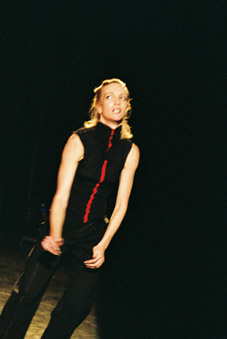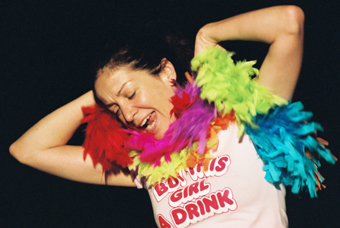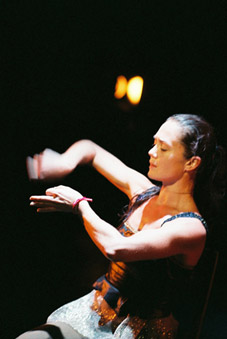Written: body, culture, history
Keith Gallasch at Onextra’s Solo Series #2
From out of the dark, to the anxious sounds of accelerated scribbling, tearing and tense breathing, emerges a quivering Fiona Malone, tightly framed by light, close to but looking through us and anxiously into herself. The torso twitches, the arms hang and jerk. A tunnel of light opens behind her. She backs along it, pieces of torn paper falling from her mouth. She is revealed again, collapsing into herself in a small square of light. Now she appears stretched out, trapped in a coffin of green light, twitching the length of her long body, arms momentarily floating, rigidifying. She reappears, half-stooped, moving towards us, almost confident, but the arms are now defensive, as if brushing something away, her head up, then down amidst oppressive crowd noises and metal raspings. In the sudden dark there are cries and crashes as her body hits the floor. In a rectangle of low light she writes with chalk on the floor, her body sometimes a template, but erasing patterns and words as she drags herself across them. For a while she looks free and fluent (even if the expression of it seems to come to nothing) and then tense as she struggles to write on her skin. Voices fill the space, speaking of loss of control and self-destruction. She erases, she writes again, she falters, she cannot bring the chalk to the floor, her arms flail about her. A spot glares from the distance, silhouetting a half naked Malone moving freely. The light then opens out into a low unbounded wash of colour and as the dancer nears us, patterned symbols form and glow on her flesh.

Fiona Malone, Reticence
photo Heidrun Löhr
Fiona Malone, Reticence
This is dance as interior monologue, where thoughts and feelings have to be read from the performer’s body (save for the one cluster of rather literal voice-overs). And what we read is anxiety about self-expression, the struggle to record or to dance it (a deliberately limited vocabulary of taut, small gestures and moves, like a body blocked). In the end, comes the recognition that all this is already written, in and on us. In this measured, nervy work, Fiona Malone displays a consistency of tone and a careful development of theme, sustaining a demanding state of being. There are occasional longueurs where small moves seems to express little (Malone stretched out in the rectangle of green light), frustration for some over the opacity of what is actually written, and a desire for the choreography to be more expansive, a little more shaped. Known for her engagement with digital technology in other works, Malone here choreographs on herself an almost animated persona, building an image from one or 2 parts of the body and small gestures, until we get the whole picture.

Kay Armstrong, a.k.a
photo Hedirun Löhr
Kay Armstrong, a.k.a
In a.k.a. Kay Armstrong appeared as entertainer in various modes across the evening: greeting us in the courtyard with glittering top hat, quips and little magic tricks; chatty dancer loaded up with professional gear like artist-as-bag-lady; dancer recalling flamenco hand moves, deftly delivered in long corridors of light, but stamping only to flatten a beckoning pack of cigarettes; and failed stand-up comic, desparate to please. Coming from the artist who gave us the powerfully performed and constructed Narrow House (RT 61, p48), this was light fare, and not enough of it written by the body.

Liz Lea, DhIVA
photo Heidrun Löhr
Liz Lea, DhIVA
Written into Liz Lea’s body are multiple histories and cultures of dance displayed with great precision, furious energy and a strength you can feel through the vibrating floor in DhIVA, choreographed by Canadian Roger Sinha. Like Malone, Lea too suggests hesitancy, intially rocking in a reflective mood on a chair before springing into action, or pausing her vigorous dance to declare, “I’m a…I’m a…” But such inarticulacy is strictly temporary as Lea flies into action. Here it’s dance as essay, informed by observations about contrasts between the Western and Eastern dance languages her body so eloquently speaks, the hybridity of ballet (its absorption of European folk dance presented here with hilariously overwrought gusto), and a commitment to Indian dance in particular.
Onextra, Solo Series #2, Fiona Malone, Reticence, lighting Clytie Smith; Kay Armstrong, a.k.a, lighting Clytie Smith; Liz Lea, DhIVA, choreographer Roger Sinha, lighting Karen Norris; Performance Space, March 16-26
RealTime issue #72 April-May 2006 pg. 34






